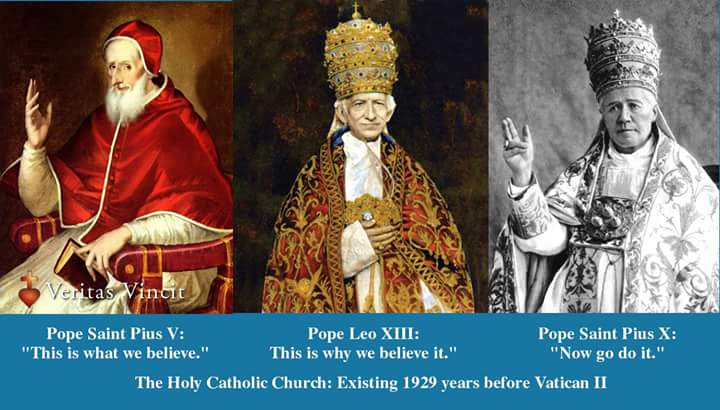There has been a meme making the rounds on Facebook for awhile now. Showing images of the last three pontiffs, it states: Pope John Paul II “This is what we believe”, Pope Benedict XVI “This is why we believe it”, Pope Francis “Now go do it”:
Despite the good intentions of those who made it, I have always found this meme problematic. In only referencing the three most recent popes, we diminish one of the most compelling truths of Catholicism: the Church goes back two thousand years! While it is understandable to be drawn to that which we are most familiar with, our faith offers us so much more depth than that.
That brings us to the meme at the very top of this post. In an obvious response to the other image, this picture presents us with a sixteenth century pope (St. Pius V), a nineteenth century pope (Leo XIII), and an early twentieth century pope (St. Piux X). This then is the Church presented as something which transcends a particular era, something greater than just the Church of now. It also stands as a contradiction to those who would see the Church and the papacy only through a post-conciliar lens.
I am reminded of a brilliant article written by Fr. Chad Ripperger several years ago. In the below excerpt, Father explains how the magisterialism and postivism prevalent among many Catholics can be a serious problem, particularly in a time of ecclesial crisis. Ultimately, Ripperger argues, it is traditionalism that provides the proper lens by which the faithful must view the faith in general, and the Magisterium in particular. From his post:
“Magisterialism is a fixation on the teachings that pertain only to the current Magisterium. Since extrinsic tradition has been subverted and since the Vatican tends to promulgate documents exhibiting a lack of concern regarding some previous magisterial acts, many have begun ignoring the previous magisterial acts and now listen only to the current Magisterium.
[…]
“Neoconservatives have fallen into this way of thinking. The only standard by which they judge orthodoxy is whether or not one follows the current Magisterium. As a general rule, traditionalists tend to be orthodox in the sense that they are obedient to the current Magisterium, even though they disagree about matters of discipline and have some reservations about certain aspects of current magisterial teachings that seem to contradict the previous Magisterium (e.g., the role of the ecumenical movement). Traditionalists tend to take not just the current Magisterium as their norm but also Scripture, intrinsic tradition, extrinsic tradition and the current Magisterium as the principles of judgment of correct Catholic thinking. This is what distinguishes traditionalists and neoconservatives.
“Inevitably, this magisterialism has led to a form of positivism. Since there are no principles of judgment other than the current Magisterium, whatever the current Magisterium says is always what is “orthodox.” In other words, psychologically the neoconservatives have been left in a position in which the extrinsic and intrinsic tradition are no longer included in the norms of judging whether something is orthodox or not. As a result, whatever comes out of the Vatican, regardless of its authoritative weight, is to be held, even if it contradicts what was taught with comparable authority in the past. Since non-infallible ordinary acts of the Magisterium can be erroneous, this leaves one in a precarious situation if one takes as true only what the current Magisterium says. While we are required to give religious assent even to the non-infallible teachings of the Church, what are we to do when a magisterial document contradicts other current or previous teachings and one does not have any more authoritative weight than the other? It is too simplistic merely to say that we are to follow the current teaching. What would happen if in a period of crisis, like our own, a non-infallible ordinary magisterial teaching contradicted what was in fact the truth? If one part of the Magisterium contradicts another, both being at the same level, which is to believed?
“Unfortunately, what has happened is that many neoconservatives have acted as if non-infallible ordinary magisterial teachings…are, in fact, infallible when the current Magisterium promulgates them. This is a positivist mentality. Many of the things that neoconservatives do are the result of implicitly adopting principles that they have not fully or explicitly considered. Many of them would deny this characterization because they do not intellectually hold to what, in fact, are their operative principles.
“As the positivism and magisterialism grew and the extrinsic tradition no longer remained a norm for judging what should and should not be done, neoconservatives accepted the notion that the Church must adapt to the modern world. Thus rather than helping the modern world to adapt to the teachings of the Church, the reverse process has occurred. This has led to an excessive concern with holding politically correct positions on secular matters. Rather than having a certain distrust of the world – which Christ exhorts us to have – many priests will teach something from the pulpit only as long as it is not going to cause problems…”




